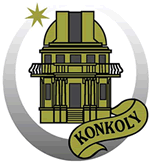
Description of the RI
The most important astronomical observatory in Hungary, hosting the largest telescopes of the country. (High-speed) photometry, and small and medium resolution spectroscopy are available. The Ritchey-Chrétien-Coudé telescope with 1m diameter main mirror was installed in 1975 and is the largest astronomical telescope of the country. Its focal length is 13.5 meters. The 10560 x 10560 pixel CCD-camera and the 3x3 degree field of view of the 60/90/180 cm Schmidt-camera is unique. Currently it is used to discover near-earth asteroids. A new 80 cm ASA robotic telescope was installed in 2018. Its main task is to discover and monitor astrophysical transient objects. All the telescopes can be operated remotely, while the software of the 80 cm telescope is able to automatically assemble the target list to be observe, and to update it dynamically. Our Fly's Eye system continuously monitors the whole visible sky with 19 cameras. The instruments contain a meteor camera system with a nation-wide coverage, and an ionosphere radar (located in Nagycenk).
The instruments and telescopes are operated by the astronomer on duty. Telescope time applications can be submitted three times a year. Telescope time is awarded in 1-week quanta, but certain objects requiring frequent monitoring for weeks-months, but with short individual exposures can also be accommodated (queue program).
Activities and Services
Activities: astronomical photometry, high-speed photometry, and spectroscopy. Photometry and spectroscopy of pulsating variable stars, eclipsing binaries active stars, exoplanets, and their host stars. Long-term monitoring of young stellar objects. Follow-up observations in international campaigns to aid space missions (Kepler/K2, TESS, Gaia, CHEOPS, Spitzer, etc.) Observing occultations of asteroids, discovery and monitoring of solar system objects, as well as astrophysical transients (novae, supernovae, gamma-ray bursts, etc.).
It is important to note that Piszkéstető Observatory has a paramount role in training the new generations of astronomers and astrophysicists. Under the auspices of the research assistant program of the Astronomical Institute dozens of university students use the telescopes and instruments while working on a research project. We also offer hands-on laboratory courses for universities, supervision of BSc/MSc thesis programs and even practical training for high-school students who were selected to be members of the Hungarian team at the International Olympiad on Astronomy and Astrophysics.
Single sited
Eötvös Loránd Research Network (ELKH), Research Centre for Astronomy and Earth Sciences, Konkoly Thege Mikós Astronomical Institute
Mátraszentimre, Galyatető
Fully operational, 1962-
- ELTE Gothard Astrophysical Observatory
- SZTE Baja Observatory
INTERNATIONAL COLLABORATION
with RIs
- Joint Research Centre Petten (JRC)
- French Alternative Energies and Atomic Energy Commission (CEA)
- Montanuniversität Leoben (MU Leoben)
- VTT Research Centre (VTT)
- Framatome GmbH (Framatome)
- Instituto de Astrofísica de Andalucía
- Astronomical Observatory Institute, Faculty of Physics, A. Mickiewicz University
- European Space Agency
- University of Cambridge
- Gaia DPAC
- NASA/ESA – ULYSSES Consortium (approved large program for the Hubble Space Telescope)







